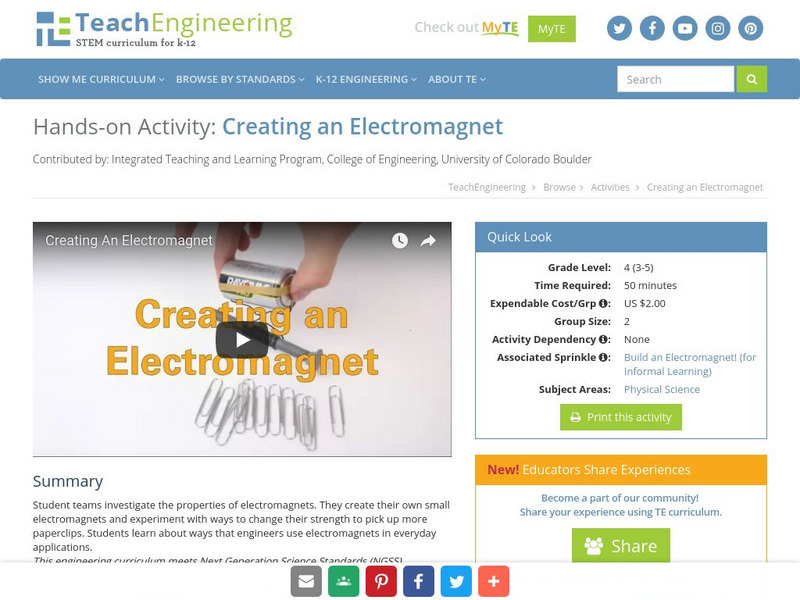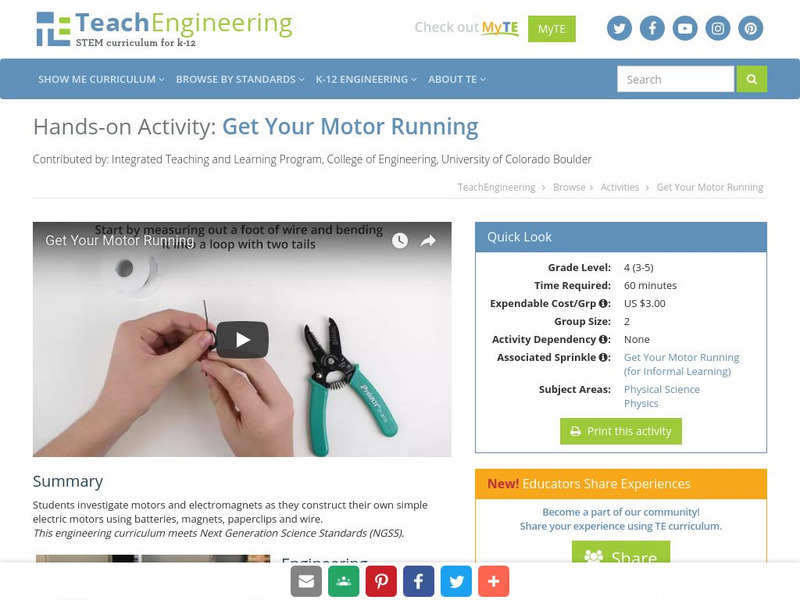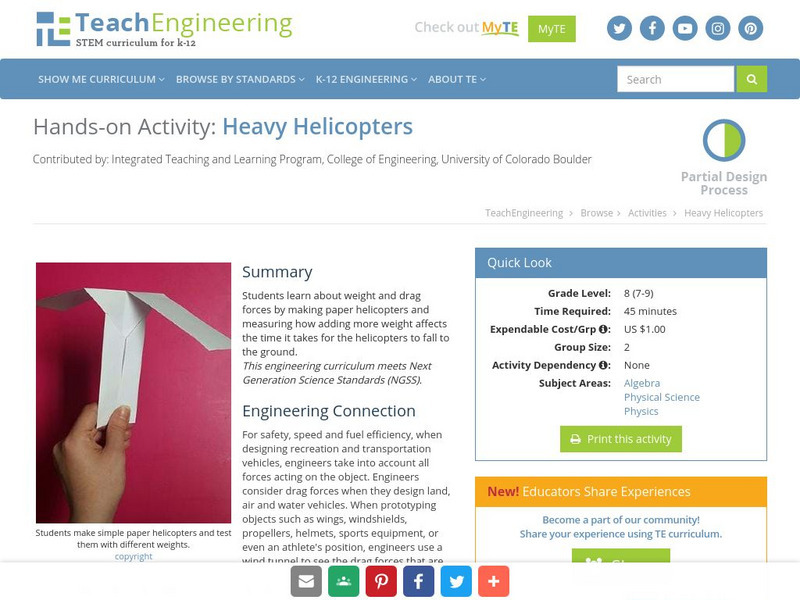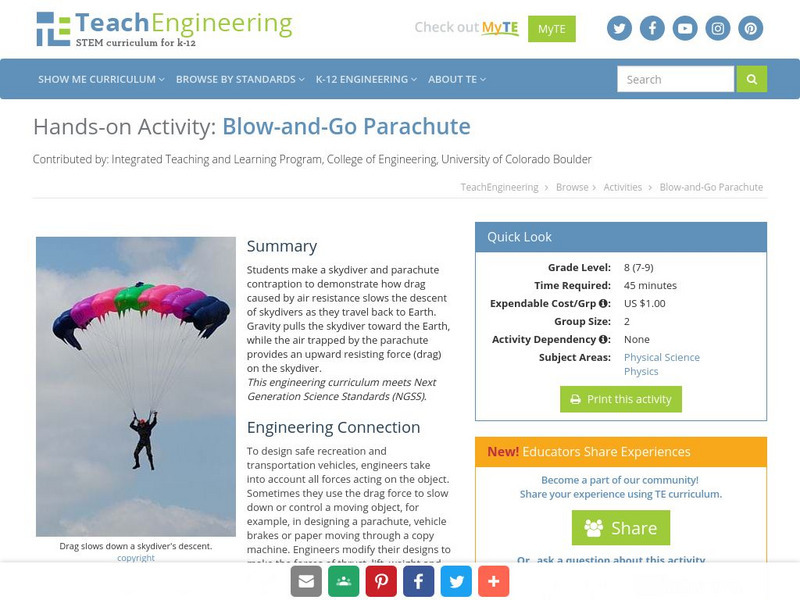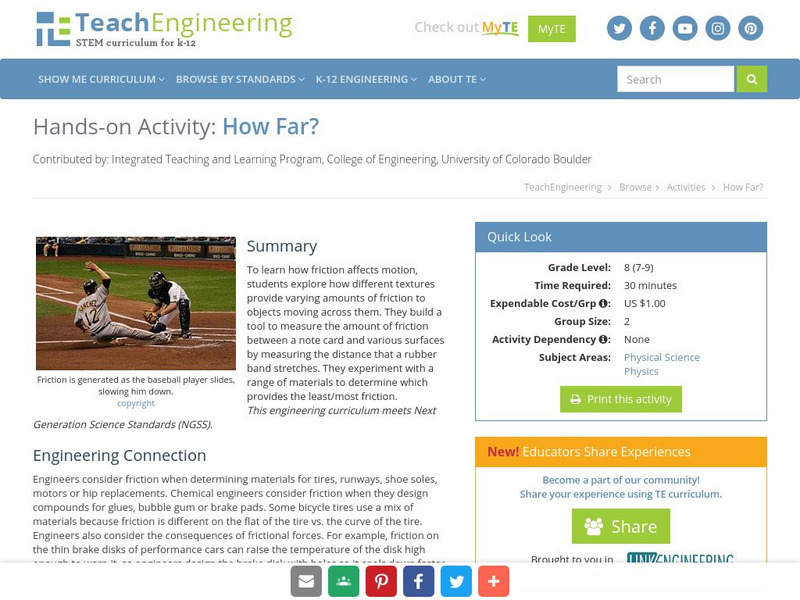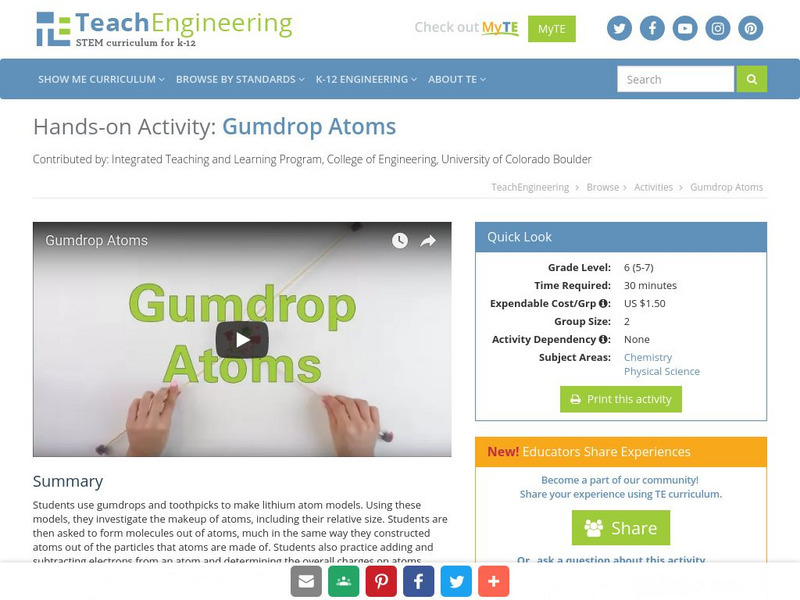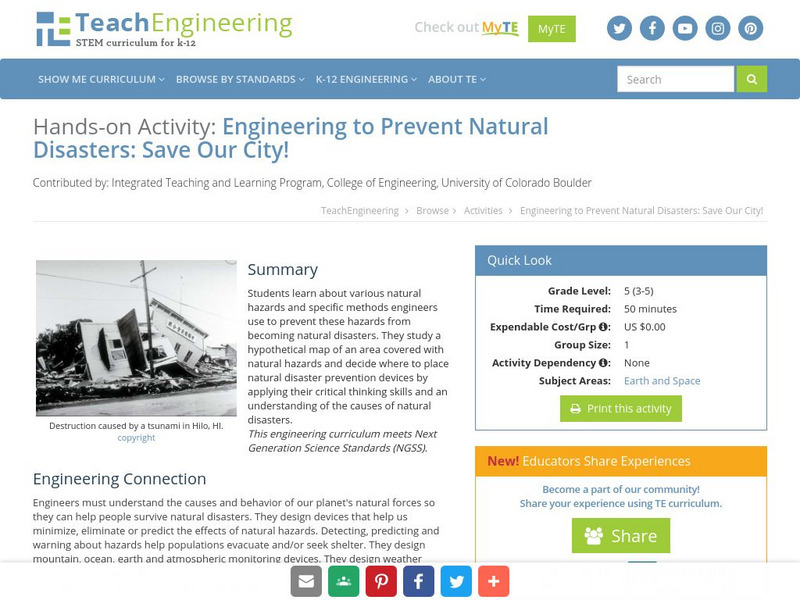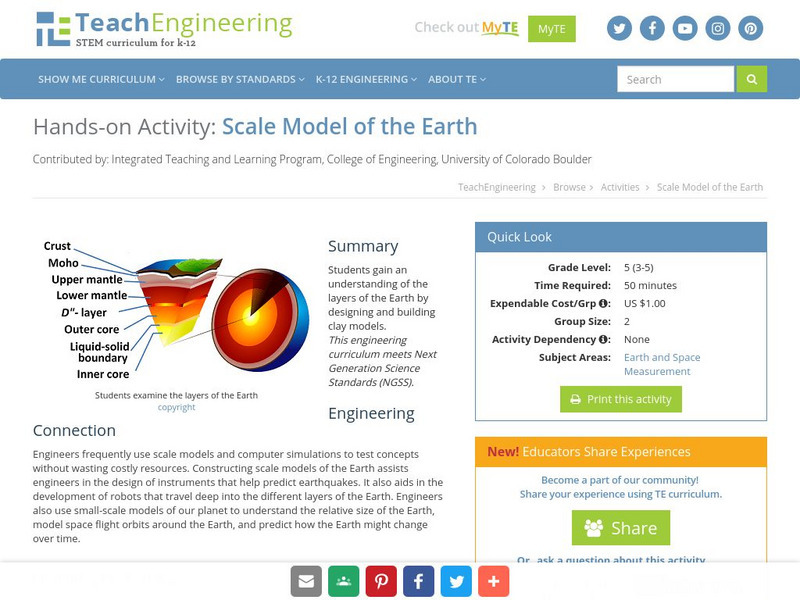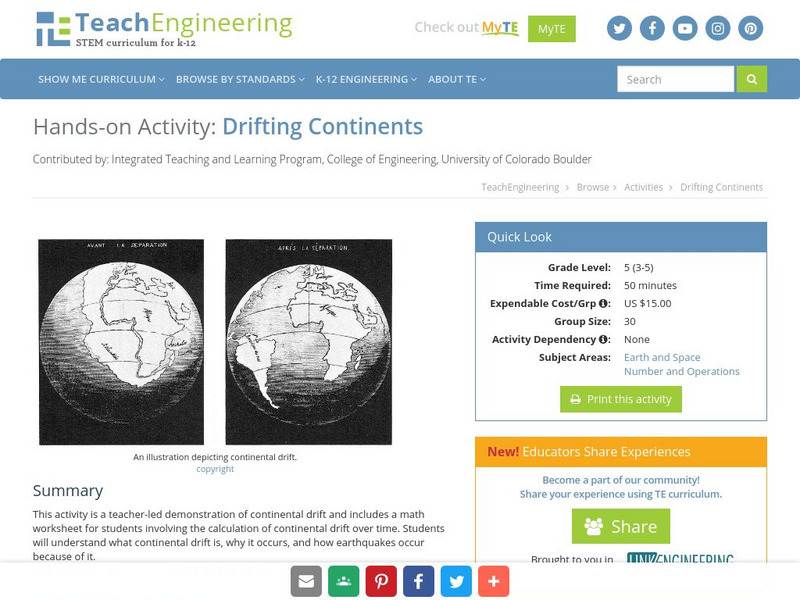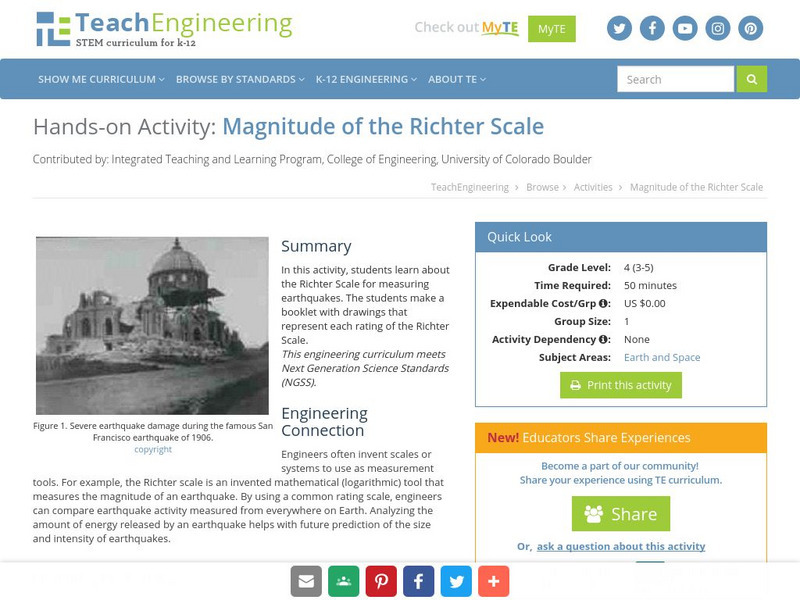TeachEngineering
Teach Engineering: Building an Electromagnet
Student teams investigate the properties of electromagnets. They create their own small electromagnet and experiment with ways to change its strength to pick up more paper clips. Students learn about ways that engineers use...
TeachEngineering
Teach Engineering: Get Your Motor Running
Students investigate motors and electromagnets as they construct their own simple electric motors using batteries, magnets, paper clips and wire.
TeachEngineering
Teach Engineering: Egg Cellent Landing
The purpose of this activity is to recreate the classic egg-drop experiment with an analogy to the Mars rover landing. The concept of terminal velocity will be introduced, and students will perform several velocity calculations. Also,...
TeachEngineering
Teach Engineering: Heavy Helicopters
Students learn about weight and drag forces by making paper helicopters and measuring how adding more weight affects the time it takes for the helicopters to fall to the ground.
TeachEngineering
Teach Engineering: Blow and Go Parachute
Students make a skydiver and parachute contraption to demonstrate how drag caused by air resistance slows the descent of skydivers as they travel back to Earth. Gravity pulls the skydiver toward the Earth, while the air trapped by the...
TeachEngineering
Teach Engineering: You Are There, First Flight
Students learn about archives and primary sources as they research original historical documents. While preparing an imaginative first-person account as if witnessing an historical event, they learn to appreciate the value of the...
TeachEngineering
Teach Engineering: How Do Things Fall?
Students learn that it is incorrect to believe that heavier objects fall faster than lighter objects. By close observation of falling objects, they see that it is the amount of air resistance, not the weight of an object, which...
TeachEngineering
Teach Engineering: Hanging Around
Students learn about weight by building a spring scale and observing how it responds to objects with different masses.
TeachEngineering
Teach Engineering: How Far?
To learn how friction affects motion, students explore how different textures provide varying amounts of friction to objects moving across them. They build a tool to measure the amount of friction between a note card and various surfaces...
TeachEngineering
Teach Engineering: Tightrope Trials
To learn about the concept of center of mass, students examine how objects balance. They make symmetrical cut-outs of different "creatures" and experiment with how they balance on a tightrope of string. Students see the concept of center...
TeachEngineering
Teach Engineering: Perching Parrot
Students explore the concepts of center of mass and static equilibrium by seeing how non-symmetrical objects balance. Using a paper cut-out shape of a parrot sitting on a wire coat hanger, they learn that their parrot exists in stable...
TeachEngineering
Teach Engineering: Wow! That Captures It!
Students learn how motion capture (mo-cap) technology enables computer animators to create realistic effects. They learn the importance of center of gravity in animation and how to use the concept of center of gravity in writing an...
TeachEngineering
Teach Engineering: Super Spinners!
Use this hands-on activity to demonstrate rotational inertia, rotational speed, angular momentum, and velocity. Students build at least two simple spinners to conduct experiments with different mass distributions and shapes, as they...
TeachEngineering
Teach Engineering: Spin Me a Story
In a spin-off to studying about angular momentum, students use basic methods of comparative mythology to consider why spinning and weaving are common motifs in creation myths and folktales. Note: The literacy activities for the Mechanics...
TeachEngineering
Teach Engineering: Leaning Tower of Pasta
Using spaghetti and marshmallows, students experiment with different structures to determine which ones are able to handle the greatest amount of load. Their experiments help them to further understand the effects that compression and...
TeachEngineering
Teach Engineering: Gumdrop Atoms
In this activity, students make a model of a lithium atom using gumdrops and toothpicks. Using this model, they investigate the makeup of an atom, including its relative size. Students also practice adding and subtracting electrons from...
TeachEngineering
Teach Engineering: Messin' With Mixtures
In this activity, students investigate the properties of a heterogeneous mixture, trail mix, as if it were a contaminated soil sample near a construction site. This activity shows students that heterogeneous mixtures can be separated by...
TeachEngineering
Teach Engineering: Save Our City!
Students learn about various natural hazards and specific methods engineers use to prevent these hazards from becoming natural disasters. They study a hypothetical map of an area covered with natural hazards and decide where to place...
TeachEngineering
Teach Engineering: Scale Model of the Earth
In this activity, students gain an understanding of the layers of the Earth by designing and building a clay model.
TeachEngineering
Teach Engineering: Drifting Continents
This activity is a teacher-led demonstration of continental drift and includes a math worksheet for students involving the calculation of continental drift over time. Students will understand what continental drift is, why it occurs, and...
TeachEngineering
Teach Engineering: Faulty Movement
In this activity, students are introduced to faults. They will learn about different kinds of faults and understand their relationship to earthquakes. The students will build cardboard models of the three different types of faults as...
TeachEngineering
Teach Engineering: Mercalli Scale Illustrated
In this activity, students will learn about the Mercalli Scale for rating earthquakes. Also, students will make a booklet with drawings that represent each rating of the scale.
TeachEngineering
Teach Engineering: Magnitude of the Richter Scale
In this activity, students will learn about the Richter Scale for measuring earthquakes. The students will make a booklet with drawings that represent each rating of the Richter Scale.
TeachEngineering
Teach Engineering: Windstorm
In this activity, students will learn about how tornadoes are formed and what they look like. By creating a water vortex in a soda bottle, they will get a first-hand look at tornadoes.


